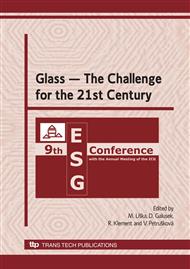p.111
p.117
p.123
p.129
p.137
p.147
p.153
p.159
p.165
Poisson's Ratio and the Glass Network Topology - Relevance to High Pressure Densification and Indentation Behavior
Abstract:
Although Poisson's ratio (ν) is a macroscopic elastic parameter it depends much on the fine details of the atomic packing. Glasses exhibit a wide range of values for from 0.1 to 0.4 which correlate to the glass network polymerisation degree, hence reproducing at the atomic scale what is observed in cellular materials at the macroscopic scale[1]. As for pure oxide glasses, we found in various multi-component glasses built on ionic-, covalent- or Van der Waals bonds that an increase of Poisson’s ratio corresponds to a decrease of the atomic network crosslink degree[2]. Noteworthy, an extension of this analysis to the case of metallic glasses correlate the recently proposed cluster-like network structure for these glasses[3,4]. A general feature is that a highly cross-linked atomic network results in a glass with a low atomic packing density (large free volume fraction), as exemplified with the case of amorphous silica. The lower the atomic packing density is and the larger the volume change the glass experiences under high pressure (1 to 25 GPa). Indentation experiments with sharp indenters (such as the Vickers one) give birth to hydrostatic stresses of the same order of magnitude and thus induce glass densification. There is hence a direct correlation between ν (reflecting the packing density) and the indentation behavior[5].
Info:
Periodical:
Pages:
137-146
Citation:
Online since:
April 2008
Authors:
Keywords:
Price:
Сopyright:
© 2008 Trans Tech Publications Ltd. All Rights Reserved
Share:
Citation:


